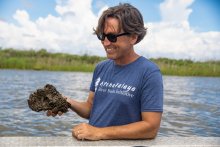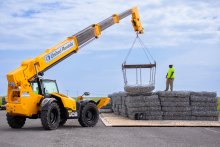Restoring Resilience–Completion of the West Cove Living Shoreline in Louisiana
July 23, 2024
In June 2024, NOAA and our partners completed the West Cove Living Shoreline–a selected restoration project from the Damage Assessment, Remediation, and Restoration Program’s Final Restoration Plan and Environmental Assessment (PDF, 101 pages) of the Shell Green Canyon 248 oil spill.
West Cove sits on the west side of Calcasieu Lake, surrounded by a large mix of salt and fresh-water marshes nestled within the Sabine National Wildlife Refuge in Cameron Parish, Louisiana. The spill damaged fish, bird, and marine mammal habitats and along the West Cove shoreline, in particular, protective reefs. The project was selected to address such damage and restore lost habitats.
Ultimately, The Nature Conservancy (TNC) created 1.5 miles of living shoreline in West Cove with a goal of restoring pelagic fish biomass. They used large galvanized mesh gabion baskets filled with limestone, placed by a barge-mounted crane to naturally recruit wild oyster spat and grow protective reefs on the baskets. This follows TNC’s independently-funded construction of a 2.5 mile living shoreline in West Cove during Phase I of the project from 2017 to 2022.
The project also supported other issues near Calcasieu Lake. Waterflow of the coastal marshes have been altered by numerous access canals and the Gulf Intracoastal Waterway. Additionally, local boat action and high-wind energy have caused marsh erosion while land subsidence and sea-level rise have contributed to wetland erosion and approximately a quarter inch per year in water level rise.
Oysters–Guardians of the Wetlands
Protecting critical coastal marsh habitat will help sustain the benefits it provides to species injured by the pollution. The shoreline fortification from the West Cove Living Shoreline project will support a high diversity of fish and wildlife populations in the Sabine National Wildlife Refuge. The project will also:
- Create habitat for important estuarine species
- Promote oyster growth
- Enhance estuary water quality
- Slow shoreline retreat by abating wave energy
High-quality estuarine habitats such as oyster reefs are essential for supporting reproduction, growth, and productivity for fish that are typically targeted by recreational fishing, such as red drum. The marsh is an important component of the fisheries food web, and also provides important edge habitat for fisheries, both of which contribute to fisheries production.
The West Cove Shoreline project has both short and long-term benefits for essential fish habitat, including marshes, subtidal habitats, and oyster substrate. By placing gabion units along the shoreline, erosion is slowed, maintaining the critical edge habitat where marsh meets the water. Marsh habitat is essential for many fish and crustaceans, serving as a transition zone between different parts of the estuary.
As Seth Blitch, Director of Conservation for the Nature Conservancy in Louisiana noted, the project boasts many resilience benefits:
“We designed the project to bring back oysters as a habitat, which would help augment the fishery, so there’s an economic resilience built into that. The immediate benefit we got from it was that this is Louisiana–with a very heavily and rapidly eroding shoreline, and the highest rate of relative sea-level rise on the planet. Because there is a little bit of vertical relief to this project, it started to reflect and abate some of the wave energy to the shoreline, so we started to see the rates of shoreline erosion actually lessen. With each subsequent phase of the project, slowing wave energy down, the sediment that was in suspension falls out of suspension, and starts to build up the shoreline. So much so, to the degree that folks at NRCS wanted to come and plant some spartina behind it because it felt like the shoreline had become stable enough so there wasn’t as much risk involved in doing that.”
The West Cove Shoreline project not only serves the habitats and species along the shoreline, it also benefits humans. Seth added:
“Biologically and ecologically, you’re losing one of the most productive habitats on the planet which is salt marsh, so all the production associated with that becomes more and more diminished the more habitat you lose. But practically, and from the human side, is that LA SR-27 runs along the shoreline, and on the west side of Calcasieu Lake, it’s the only evacuation route for a hurricane, and so the more it protects the marsh, and the built infrastructure, there are demonstrable public health and safety benefits that go along with this work.”
Another draw to the West Cove Living Shoreline project’s restoration work is the ever-growing popularity of oysters on restaurant menus. The April 2, 2024 episode of the popular Gastropod Podcast—The World Is Your Oyster: How Our Favorite Shellfish Could Save Coastlines Worldwide—not only discussed the variety of oyster species and flavor profiles but also the critical role that oysters play in coastal habitats. Seth Blitch, Director of Conservation for the Nature Conservancy in Louisiana joined the podcast, discussing the importance of this project in particular.
What Happened?
On May 11, 2016, the U.S. Coast Guard responded to a crude oil spill discharged from a Shell Offshore, Inc. well-head flow line in the Green Canyon Block 248 subsea oil production system. This system is located approximately 97 miles south of Timbalier Island, Louisiana. The oil leaked from a piping system used to transport oil from a production well on the seafloor. Shell reported to DOI’s Bureau of Safety and Environmental Enforcement that the incident resulted in an estimated discharge of 1,926 barrels of oil, or 80,892 gallons, into the waters of the Gulf of Mexico.
In collaboration with state and federal trustees, NOAA recovered funds from the company responsible for the spill to implement projects to address the natural resource injuries, including the West Cove project.
For more information and to stay in the know, sign up for DARRP’s Coastal Recovery news.








